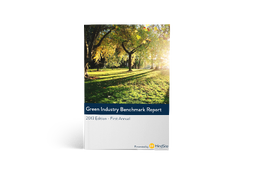
Earlier this week, we wrote a blog post with 5 tips for starting a green industry business culled from our recently released Green Industry Benchmark Report. Today, we’re going to look at 5 tips for marketing your green industry business suggested by respondents to that same survey.
Without further ado, here are 5 tips from green industry businesses just like yours:
1. Do good work and that will speak for itself.... and lead to other work. Word of mouth and reputation is the best salesman you can have.
This is by far the most common sentiment we found in the Green Industry Benchmark Survey – that you don’t need marketing! For some small businesses with a good customer base and modest growth goals, that’s probably true. They have enough business and aren’t looking to grow their business.
The other point to make: If you do good work that speaks for itself, you may be able to charge a premium for your services. Think of Apple: They have a reputation for great, easy-to-use products. Because of it, buyers are willing to pay a premium to own an Apple product. It’s why they can have profit margins in the 40% range, and are the envy of other hardware manufacturers.
2. Have a really good website - it is the front landscaping to your electronic "Business building"........ It is the first impression people have of you.
I really like the analogy this respondent used: Your website is to your marketing as landscaping is to your business address. It truly is your business’ first impression. If you have an ugly, outdated or non-existent website, that’s the impression you’re making with your potential customer.
Your website really should be a portal into your business. I’ve seen a lot of contractor websites, and some of the better ones feature actual work performed. For instance, take the case of A+ Outdoor Services. Their work has been featured on Extreme Makeover Home Edition, and they smartly feature that work prominently on their website. It lends a lot of credibility to their work.
Another requirement for your website: Make it easy for potential customers to get in touch with you. Create a free estimate form on your website and make it extremely visible. Not only does your website need to be attractive and detail your work, but it should also be a lead generation tool. So make it easy for buyers to give you their contact information. A great example of this is the AA Waters Brookes website: They’ve got a free estimate link prominently displayed on their homepage. Clicking onto other pages, they include a phone number for a free estimate and a button to request a free estimate. It’s readily apparent from every page on their website.
To learn more about how to turn your website into a lead generation engine, check out our eBook, 6 Requirements for a Website That Sells.
3. Market to your customers. It's by far the cheapest and most effective.
More great, simple advice. Your customers are by far going to be your cheapest and most effective form of marketing. Your customers are your customers because they love the work you do. They know who you are and what to expect. You don’t have to educate them or work too hard to sell them on the value you add.
If you’re like most green industry businesses, you offer more than one service. Say you install and maintain irrigation systems and offer lawn fertilization services. You probably have a handful of customers with irrigation system maintenance contracts who don’t utilize your fertilization services. Segment your customer list to identify those customers, and then send them an email, postcard, or pick up the phone and call them and offer them a discount on fertilization services.
Another obvious tip: If you do sell contracts, create service tiers in a good, better, best structure. Identify those customers that are at the good or better level and try to move them to the best (and hopefully most profitable) level.
A final tip: Learn how to identify your best customers. Survey them to see who is most satisfied. Identify your happiest customers and upsell them services, because they’re the ones most likely to act. Or, simply try to leverage their satisfaction to drive your referral program. Whatever you do, it’s important that you understand your happy and at-risk customers so you can create marketing plans accordingly.
4. Do your research, spend in the right season. For us it is early and toward the end of season. Make sure you hit your target market, age income and zip code and don't find yourself running all over town.
We run into this at HindSite all the time – it’s vitally important that we spend at the right time of the year. Buyers of our field service management software are typically not interested in buying in the summer because it’s their busy season. It doesn’t make a lot of sense for us to spend a lot of money in the summer, because they aren’t paying attention. They’ve got a businesses to run. But in the winter, we need to be highly visible. That’s when our buyers buy.
It’s also important to know your buyer. In marketing circles there’s a concept called buyer personas that help marketers focus on their target buyer. Marketers gather as much information about their target buyer to create a fictional “persona” that represents the majority of their buyers. Or create multiple personas to represent your typical buyers.
Once you know your buyer, you can start to create more effective marketing campaigns. And by targeting specific locations, you can be more productive. For instance, if you service a residential retirement community, your messaging and marketing tactics are going to be much different than someone who services large commercial properties. By understanding your buyer, not only will you be able to service them better, but you’ll also be able to put together better marketing messages.
5. If you are exploring the Facebook/Twitter avenue, make sure someone is managing the account on a daily basis or even multiple times per day. Continually update your website(s). Brand yourself -- make a place in the market for your business; make it slightly different and appealing to prospects. Not all marketing avenues work for everyone. Unfortunately, you have to determine what works best for your business through trial and error, which means spending money that may prove to be wasted.
Our final piece of advice obviously comes from a more progressive green industry marketer looking for more aggressive growth. And he’s right – if you have a social media presence and you only post once or twice a week, you’re not doing it right. You need to be posting multiple times a day. I once heard a speaker say that on Facebook, not only are you competing with other businesses for attention, but you’re also competing with your followers’ friends, relatives and loved ones. That’s true of the social sphere, and in order to compete, you need to share really great content frequently, or you’re wasting your time.
Throw in the fact that Facebook recently announced changes that make it even harder for your posts to get seen due to feed filtering, and frequency is important. It’s also important to update your website – not just because an outdated website is aesthetically a bad idea. Frequently updated web pages are more likely to be ranked high in Google. It’s why many businesses write blogs – new, fresh content is more visible in the search engine, and more likely to be found by searchers. Budget some time every month – or even every week – to tweak your website.
It’s also Marketing 101 to consider your branding. Find something that makes you unique and create your brand around it. Again, make sure you understand your target buyer so your message/brand resonates with them.
Also, bear in mind that what works for one business isn’t going to work for another. So you need to always be trying new marketing tactics – email, search ads, direct mail, print ads, radio, etc. – so you can measure what works and what doesn’t. Like a good investment strategy, your marketing mix needs to be diversified. If you only use billboard ads, only people driving by that billboard will see your ad, and you’re limiting your reach.
As you can see, we got some great advice from survey respondents, advice that you can put to use when considering your marketing strategy for your green industry business. Have a marketing tip of your own? Drop it in the comments below.
Haven’t downloaded the Green Industry Benchmark Report? Go grab it now!








